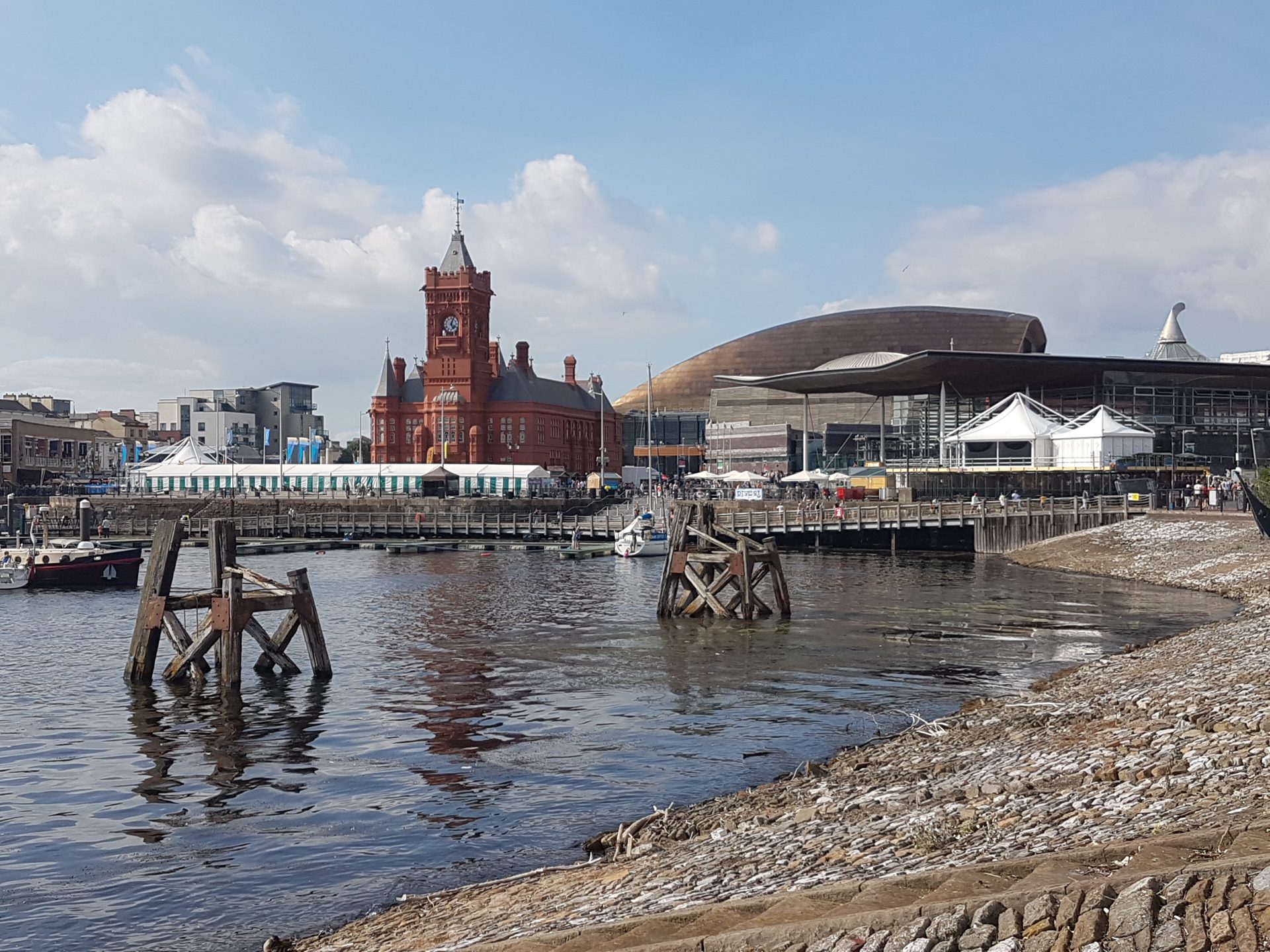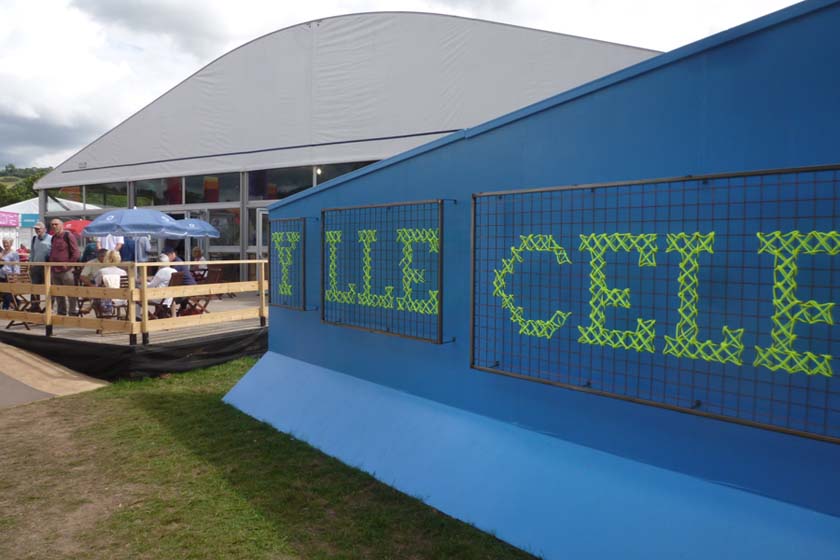|
Maes (eisteddfod)
Maes (Welsh for ''Field'') is the name commonly given to the site of a Welsh eisteddfod, such as the National Eisteddfod or the Urdd Eisteddfod. All the main events and event venues are located on the Maes. Background Central to the Maes is the competition venue, often a large temporary pavilion. From 2006 until 2014, the National Eisteddfod of Wales used a large pink pavilion, which arrived in four articulated lorries and took four days to erect. Prior to that, the pavilion had been a stripy green and yellow tent. The Maes is usually located in a field or on open farmland. In 2017 the National Eisteddfod of Wales was almost cancelled when, on the initial weekend of the event, the Maes was turned into a sea of mud by stormy weather. The carparks on nearby farmland became unusable. A later report also concluded the accessibility for disabled visitors to the Maes was inadequate. Normally the Maes is enclosed by a fence and an entrance fee is charged. However, in 2018 the National ... [...More Info...] [...Related Items...] OR: [Wikipedia] [Google] [Baidu] |
Mathrafal2003
Mathrafal near Welshpool, in Powys, Mid Wales, was the seat of the Kings and Princes of Kingdom of Powys, Powys probably from the 9th century until its destruction in 1213 by Prince Llywelyn ap Iorwerth, Llywelyn the Great. Location On the banks of the River Banwy, just above its confluence with the river Vyrnwy, about 5 km (3 miles) NE of Llanfair Caereinion and 10 km (6 miles) NW of Welshpool on the A495 road, A495 at its junction with the B4389. Description The site known today as "Mathrafal Castle" is a 90 m by 80 m compound defended by a bank and outer ditch on three sides, the fourth side being the river. Little remains of the original walls. Mathrafal is the original capital of the Kingdom of Powys, in the cantref of Caereinion. After the division of Powys in 1160 it became the capital of the southern portion which eventually became known as Powys Wenwynwyn. This structure probably replaced an earlier hill fort, about 1 km away to the NW, which dat ... [...More Info...] [...Related Items...] OR: [Wikipedia] [Google] [Baidu] |
Welsh Language
Welsh ( or ) is a Celtic language family, Celtic language of the Brittonic languages, Brittonic subgroup that is native to the Welsh people. Welsh is spoken natively in Wales, by some in England, and in Y Wladfa (the Welsh colony in Chubut Province, Argentina). Historically, it has also been known in English as "British", "Cambrian", "Cambric" and "Cymric". The Welsh Language (Wales) Measure 2011 gave the Welsh language official status in Wales. Both the Welsh and English languages are ''de jure'' official languages of the Welsh Parliament, the Senedd. According to the 2021 United Kingdom census, 2021 census, the Welsh-speaking population of Wales aged three or older was 17.8% (538,300 people) and nearly three quarters of the population in Wales said they had no Welsh language skills. Other estimates suggest that 29.7% (899,500) of people aged three or older in Wales could speak Welsh in June 2022. Almost half of all Welsh speakers consider themselves fluent Welsh speakers ... [...More Info...] [...Related Items...] OR: [Wikipedia] [Google] [Baidu] |
Wales
Wales ( cy, Cymru ) is a Countries of the United Kingdom, country that is part of the United Kingdom. It is bordered by England to the Wales–England border, east, the Irish Sea to the north and west, the Celtic Sea to the south west and the Bristol Channel to the south. It had a population in 2021 of 3,107,500 and has a total area of . Wales has over of coastline and is largely mountainous with its higher peaks in the north and central areas, including Snowdon (), its highest summit. The country lies within the Temperateness, north temperate zone and has a changeable, maritime climate. The capital and largest city is Cardiff. Welsh national identity emerged among the Celtic Britons after the Roman withdrawal from Britain in the 5th century, and Wales was formed as a Kingdom of Wales, kingdom under Gruffydd ap Llywelyn in 1055. Wales is regarded as one of the Celtic nations. The Conquest of Wales by Edward I, conquest of Wales by Edward I of England was completed by 1283, th ... [...More Info...] [...Related Items...] OR: [Wikipedia] [Google] [Baidu] |
Eisteddfod
In Welsh culture, an ''eisteddfod'' is an institution and festival with several ranked competitions, including in poetry and music. The term ''eisteddfod'', which is formed from the Welsh morphemes: , meaning 'sit', and , meaning 'be', means, according to Hywel Teifi Edwards, "sitting-together." Edwards further defines the earliest form of the eisteddfod as a competitive meeting between bards and minstrels, in which the winner was chosen by a noble or royal patron.Hywel Teifi Edwards (2015), ''The Eisteddfod'', pages 5–6. The first documented instance of such a literary festival and competition took place under the patronage of Prince Rhys ap Gruffudd of the House of Dinefwr at Cardigan Castle in 1176. However, with the loss of Welsh independence at the hands of King Edward I, the closing of the bardic schools, and the Anglicization of the Welsh nobility, it fell into abeyance. The current format owes much to an 18th-century revival, first patronized and overseen by the L ... [...More Info...] [...Related Items...] OR: [Wikipedia] [Google] [Baidu] |
National Eisteddfod Of Wales
The National Eisteddfod of Wales (Welsh language, Welsh: ') is the largest of several eisteddfodau that are held annually, mostly in Wales. Its eight days of competitions and performances are considered the largest music and poetry festival in Europe. Competitors typically number 6,000 or more, and overall attendance generally exceeds 150,000 visitors. The 2018 Cardiff National Eisteddfod, 2018 Eisteddfod was held in Cardiff Bay with a fence-free 'Maes (eisteddfod), Maes'. In 2020, the event was held virtually under the name AmGen; events were held over a one-week period. History The National Museum of Wales says that "the history of the Eisteddfod may [be] traced back to 1176 Cardigan eisteddfod, a bardic competition held by the Lord Rhys in Cardigan Castle in 1176", and local Eisteddfodau have certainly been held for many years prior to the first national Eisteddfod. There have been multiple Eisteddfodau held on a national scale in Wales, such as the Gwyneddigion Eisteddfod of , ... [...More Info...] [...Related Items...] OR: [Wikipedia] [Google] [Baidu] |
Urdd Eisteddfod
The Urdd National Eisteddfod ( cy, Eisteddfod Genedlaethol Urdd Gobaith Cymru or ''Eisteddfod Genedlaethol yr Urdd'') is an annual Welsh-language youth festival of literature, music and performing arts organised by Urdd Gobaith Cymru. Arguably Europe's largest youth festival, it is usually held during the last week of May, coinciding with schools' half term holiday. Locations alternate between north and south Wales. The Eisteddfod consists of competitive singing, recitation, art, composition, dance and instrumental events for contestants aged between 7 and 24 years. Regional qualifying heats are held in advance around Wales. Eisteddfod yr Urdd's original motto's is 'Er Mwyn Cymru' (For Wales' Sake). History The first Urdd National Eisteddfod was held in 1929 at Corwen. Originally held over two days, the festival has grown in recent times into a week-long celebration of competition and socialising. The initial festivals, which focused more on the celebration of young people enj ... [...More Info...] [...Related Items...] OR: [Wikipedia] [Google] [Baidu] |
2018 Cardiff National Eisteddfod
The 2018 Cardiff National Eisteddfod was held in Cardiff Bay, Wales, from 3 to 11 August 2018. It was the seventh time the National Eisteddfod of Wales had been held in Cardiff. The 2018 event was billed as the Eisteddfod with "No fences" because it dispensed with the traditional enclosed 'Maes', or entrance fees to the event location. It made a £290,000 loss, but its popularity led to the suggestion of future Eisteddfods without fences. Background The National Eisteddfod of Wales has been held every year (with the exception of 1914) since 1861. It is hosted by a different region of Wales each year. Since 1950 all competitions have been held in Welsh. Around 6,000 competitions are held, in poetry, music, dance, drama and literature, giving it a claim to be the largest music and poetry festival in Europe. The main competition events are the Crowning of the Bard and the Chairing of the Bard. The 2018 Eisteddfod was the seventh time it had been held in Cardiff. It was held for the ... [...More Info...] [...Related Items...] OR: [Wikipedia] [Google] [Baidu] |
Cardiff Bay
Cardiff Bay ( cy, Bae Caerdydd; historically Tiger Bay; colloquially "The Bay") is an area and freshwater lake in Cardiff, Wales. The site of a former tidal bay and estuary, it serves as the river mouth of the River Taff and Ely. The body of water was converted into a lake as part of a UK Government redevelopment project, involving the damming of the rivers by the Cardiff Bay Barrage in 1999. The barrage impounds the rivers from the Severn Estuary, providing flood defence and the creation of a permanent non-tidal high water lake with limited access to the sea, serving as a core feature of the redevelopment of the area in the 1990s. Surrounding the lake is a area of redeveloped former derelict docklands which shares its name. The area is situated between Cardiff city centre and Penarth, in the communities of Butetown and Grangetown. Its waterfront is home to notable attractions, in particular regarding Welsh politics; with devolved institutions such as the Senedd buildin ... [...More Info...] [...Related Items...] OR: [Wikipedia] [Google] [Baidu] |
Y Lle Celf
Y Lle Celf ( Welsh 'The Art Place', ) is an annual art, craft and architecture exhibition held during the National Eisteddfod of Wales, claimed to be the biggest temporary art exhibition in Europe. Description Y Lle Celf is created every year for the duration of the National Eisteddfod of Wales, the country's celebration of Welsh language and culture. The exhibition is organised by the National Eisteddfod and supported by the Arts Council of Wales. To exhibit in the exhibition, artists and designers must be either born in Wales, have Welsh parents, or have lived or worked in Wales for at least three years prior to the submission deadline, or have the ability to speak, read or write Welsh. In 2010 exhibitors were chosen from 2,500 entries. Forty finalists were chosen to exhibit. The final selection is chosen by a panel of experts. Y Lle Celf is usually housed in a temporary building on the Eisteddfod grounds, though at Ebbw Vale in 2010 it was held in the disused basement of ... [...More Info...] [...Related Items...] OR: [Wikipedia] [Google] [Baidu] |
Eisteddfod
In Welsh culture, an ''eisteddfod'' is an institution and festival with several ranked competitions, including in poetry and music. The term ''eisteddfod'', which is formed from the Welsh morphemes: , meaning 'sit', and , meaning 'be', means, according to Hywel Teifi Edwards, "sitting-together." Edwards further defines the earliest form of the eisteddfod as a competitive meeting between bards and minstrels, in which the winner was chosen by a noble or royal patron.Hywel Teifi Edwards (2015), ''The Eisteddfod'', pages 5–6. The first documented instance of such a literary festival and competition took place under the patronage of Prince Rhys ap Gruffudd of the House of Dinefwr at Cardigan Castle in 1176. However, with the loss of Welsh independence at the hands of King Edward I, the closing of the bardic schools, and the Anglicization of the Welsh nobility, it fell into abeyance. The current format owes much to an 18th-century revival, first patronized and overseen by the L ... [...More Info...] [...Related Items...] OR: [Wikipedia] [Google] [Baidu] |









